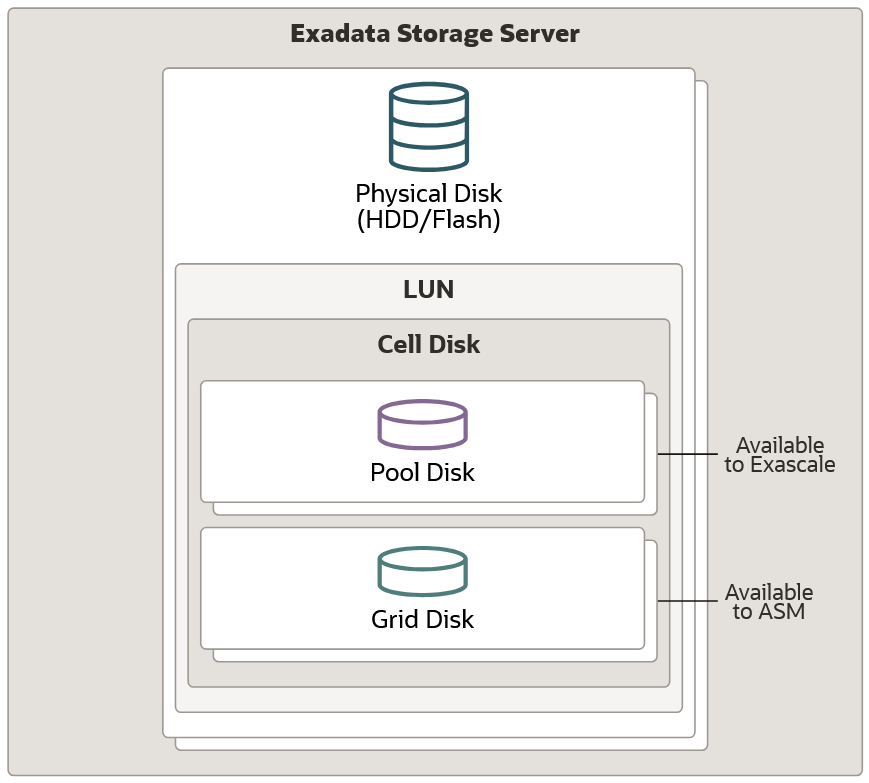Exascale is the next generation of storage management that combines multitenancy, resource pooling, and elastic database infrastructure with the performance of data-intelligent Exadata storage and Remote Direct Memory Access (RDMA). This article series aims to get you started quickly by introducing some Exascale fundamentals. This article shows through demonstration how Exadata storage is managed by Exascale—starting from the physical disks, all the way to the database files.
Starting at the lowest layer is the storage media, which describes the physical drives in the storage servers. The physical drives are partitioned and formatted as grid disks or pool disks. Storage pools are a collection of pool disks that are the same storage server type—i.e., high capacity or extreme flash. Vaults are a metadata construct and are a collection of rules and quotas for how the storage pools, flash cache, RDMA memory, and flash log will be used by the database or virtual machine. Templates determine the content type and storage media type of each type of database file, as well as the performance profile used to write the blocks to disk.

Storage Media
Exascale storage is provided by Exadata storage servers, and each storage device is categorized according to its media type. The supported media types are:
- High Capacity (HC) – Identifies high capacity storage media, which uses hard disk drives (HDD)
- Extreme Flash (EF) – Identifies extreme flash storage media, which uses capacity-optimized flash devices
Creating a storage server cell disk reserves a physical disk for use by Exadata System Software. A cell disk has a one-to-one relationship with a physical disk. Creating a grid disk or pool disk reserves part or all of a cell disk to be used by ASM or Exascale. Grid disks can be added to an ASM disk group. Pool disks can be added to an Exascale storage pool.
Pool Disks
Exascale uses pool disks and storage pools to organize the physical storage provided by Exadata storage servers. A pool disk is a storage server disk allocation that is reserved for use by Exascale. The lsgriddisk command in escli displays all Exadata grid disks used by ASM, as well as pool disks used by Exascale, that have been created and are accessible to the Exascale cluster. In this example, the pool disks are labeled with a prefix of pool. There are also grid disks labeled with a prefix of DATA and RECO, which indicates that this storage server is also being utilized in ASM disk groups.
@>lsgriddisk
size diskType cellDisk status name
3298534883328 HardDisk CD_00_cell01 active DATAC1_CD_00_cell01
3298534883328 HardDisk CD_01_cell01 active DATAC1_CD_01_cell01
...
2199023255552 HardDisk CD_00_cell01 active RECOC1_CD_00_cell01
2199023255552 HardDisk CD_01_cell01 active RECOC1_CD_01_cell01
...
14300596928512 HardDisk CD_00_cell01 active pool1_CD_00_cell01
14300596928512 HardDisk CD_01_cell01 active pool1_CD_01_cell01
...If you want to only see the pool disks belonging to Exascale storage pools, you can add a filter to the query. ASM grid disks do not have a value in the storagePool attribute.
@>lsgriddisk --filter storagePool>""
size diskType cellDisk status name
14300596928512 HardDisk CD_00_cell01 active pool1_CD_00_cell01
14300596928512 HardDisk CD_01_cell01 active pool1_CD_01_cell01
...Viewing the details of a pool disk with the –detail parameter, shows additional information common to both pool and grid disks.
@>lsgriddisk --detail --filter name="pool1_CD_00_cell01"
id pool1_CD_00_cell01@cell01
name pool1_CD_00_cell01
cachedBy FD_02_cell01
cachingPolicy default
cell cell01
cellDisk CD_00_cell01
creationTime 1970-01-01T00:00:00-00:00
diskType HardDisk
poolDiskStatus online
size 14300596928512
spaceUsed 42147774464
status active
storagePool pool1
uuid e09863fc-279a-48c3-924f-5a1a7eeeaf00The lspooldisk command in escli shows similar information to the lsgriddisk command, but only shows the storage partitions allocated as pool disks.
@>lspooldisk --detail --count 1
id 148
name cell01_.28_5042_8/pool1_CD_00_cell01
cellId 73
gdName pool1_CD_00_cell01
healthy true
incarnation 13
size 13.006317138671875T
state Uninitialized
status ONLINE
storagePool pool1Storage pools
A storage pool is a collection of pool disks that provides persistent physical storage for Exascale vaults and files. Each storage pool is a collection of pool disks using only one type of storage media—i.e., one of High Capacity (HC) or Extreme Flash (EF). You cannot define a storage pool with pool disks having a mixture of storage media types.
An Exascale cluster has one or more storage pools. A storage pool can contain pool disks that reside on different generations of Exadata storage server hardware, which allows for easy expansion to new generations of Exadata hardware.
The lsstoragepool command in escli shows a significant amount of detail about the storage pools. In this example, there is only one storage pool in the Exascale cluster called pool1. The cellsCount and disksCount attributes show that there are five different storage servers with a total among them of 60 grid disks allocated to this storage pool. The mediaType attribute shows that this storage pool is comprised of High Capacity (HC) storage disks.
@>lsstoragepool --detail
id pool1
name pool1
cellOfflineTimerInMins 1440
cellsCount 5
diskOfflineTimerInMins 120
disksCount 60
flashCacheProvisionableSize 86.94542255174383171834051609039306640625T
flashCacheProvisionedSize 0
guid 4081be6e-e54f134d-dd230bf-d6722bd5
highDataStatus available
highRecoStatus available
inReconfig false
iopsProvisionable 3520560
iopsProvisioned 0
iopsRaw 3520560
mediaType HC
spaceProvisionable 780.3790283203125T
spaceProvisioned 50T
spaceRaw 780.3790283203125T
spaceUsed 2.572264492511749267578125T
sysDataStorePresent true
sysDataStoreShardsCount 20
xrmemCacheProvisionableSize 4.4261037441538064740598201751708984375T
xrmemCacheProvisionedSize 0Files
Exascale is optimized to directly store and manage files associated with Oracle Database and Oracle Grid Infrastructure. Exascale automatically understands the type of files that it is managing. By using a template that is associated with the file type, Exascale automatically applies the appropriate file storage attributes. This process indirectly determines the storage pool that houses the file. Unlike ASM, Exascale does not need separate storage entities like disk groups for files needing different performance, or disk placement characteristics. For example, a datafile may be assigned the characteristics of placement on high capacity disk storage, and extents located on separate physical drives from online log files—whereas an online log file may be assigned the characteristics of placement on capacity-optimized flash storage, and extents located on separate physical drives from datafiles. Both of these files can be created in the same logical storage container (vault), and Exascale will handle where and how the extents are written to and read from storage.
Vaults
An Exascale vault is a logical container that groups and limits the storage resources provided by the storage servers. To an administrator and Oracle Database, a vault appears like a top-level directory that contains files. A fully qualified Exascale file path always begins with the ampersand (@) character and the vault name, followed by the rest of the file path (e.g., @MYVAULT/myexample/myfilename).
A vault (and all the databases/VMs with access to it) will be able to use all the storage resources in all of the storage pools in the cluster, by default. For example, the cluster in the following example has both an HC storage pool and an EF storage pool. When I create the MYVAULT_ALL vault without any attributes, it has access to all the capacity and performance resources of both storage pools.
@>mkvault MYVAULT_ALL
Vault @MYVAULT_ALL created.
@>lsvault --detail MYVAULT_ALL
id MYVAULT_ALL
flashCacheProv unlimited
flashLogProv true
iopsProvEF unlimited
iopsProvHC unlimited
spaceProvEF unlimited
spaceProvHC unlimited
xrmemCacheProvEF unlimited
xrmemCacheProvHC unlimitedThe escli command mkvault MYVAULT_HC_UNLIMITED –attributes spaceProvHC=unlimited restricts the type and amount of storage resources accessible to the vault by adding the spaceProvHC attribute. Vault attributes are explicit for each storage pool, meaning that once you add an attribute to the mkvault command, the vault is restricted to only those storage pool resources. The MYVAULT_HC_UNLIMITED vault has unlimited access to the capacity and performance resources of only the HC storage pool by adding the spaceProvHC=unlimited attribute. Alternatively, the command mkvault MYVAULT_HC_UNLIMITED –attributes spaceProvEF=0,iopsProvEF=0 would achieve the same result.
@>mkvault MYVAULT_HC_UNLIMITED --attributes spaceProvHC=unlimited
Vault @MYVAULT_HC_UNLIMITED created.
@>lsvault --detail MYVAULT_HC_UNLIMITED
id MYVAULT_HC_UNLIMITED
flashCacheProv unlimited
flashLogProv true
iopsProvEF 0
iopsProvHC unlimited
spaceProvEF 0
spaceProvHC unlimited
xrmemCacheProvEF 0
xrmemCacheProvHC unlimitedAdding additional attributes will further restrict the storage resources available to the vault.
@>mkvault MYVAULT_HC_LIMITED --attributes spaceProvHC=1T,iopsProvHC=1000000,flashCacheProv=500G,xrmemCacheProvHC=500G
Vault @MYVAULT_HC_LIMITED created.
@>lsvault --detail MYVAULT_HC_LIMITED
id MYVAULT_HC_LIMITED
flashCacheProv 500G
flashLogProv true
iopsProvEF 0
iopsProvHC 1000000
spaceProvEF 0
spaceProvHC 1T
xrmemCacheProvEF 0
xrmemCacheProvHC 500GTemplates
An Exascale template is a named collection of file storage attribute settings. When a file is created in Exascale, the template associated with that file type determines how the file is stored and managed.
Templates are defined at two levels:
- Cluster Templates are defined at the cluster level. A cluster template is used if no vault-level template exists to override it.
- Vault Templates are defined at the vault level. A vault template defines vault-specific attributes that override the corresponding cluster template.
The templates define attributes such as media type, and content type. Here is a list of some of the file type templates that should look familiar.
@>lstemplate --cluster
redundancy mediaType contentType name
high HC RECO ARCHIVELOG
high HC DATA DATAFILE
high HC DATA ONLINELOG
high HC DATA PARAMETERFILE
high HC DATA PASSWORD
...When a vault is created, it will use the cluster templates, but each template can be overridden at the vault level by creating a vault template. For example, I can override the DATAFILE template for the MYVAULT_HC_AND_EF_UNLIMITED vault so that the datafiles are stored on EF storage.
@>mktemplate --vault MYVAULT_HC_AND_EF_UNLIMITED --file-type DATAFILE --media-type EF --content-type DATA
Template created: MYVAULT_HC_AND_EF_UNLIMITED/DATAFILEI can see that there is one vault-level DATAFILE template overriding the cluster level template.
@>lstemplate --vault-level-only --vault MYVAULT_HC_AND_EF_UNLIMITED
redundancy mediaType contentType name
high EF DATA DATAFILEWhen a tablespace is created in the MYVAULT_HC_UNLIMITED vault, its datafiles are stored according to the cluster-level DATAFILE template, which dictates that the datafiles are stored in the HC storage pool. When a tablespace is created in the MYVAULT_HC_AND_EF_UNLIMITED vault, its datafiles are stored according to the vault-level DATAFILE template, which dictates that the datafiles are stored in the EF storage pool.
@>ls @MYVAULT_HC_UNLIMITED/ --attributes id,contentType,fileType,mediaType
id contentType fileType mediaType
@MYVAULT_HC_UNLIMITED/.../DATAFILE/MYTBSHC.OMF.776DDAB1 DATA DATAFILE HC
@MYVAULT_HC_UNLIMITED/.../DATAFILE/MYTBSHC.OMF.074E62A8 DATA DATAFILE HC
@MYVAULT_HC_UNLIMITED/.../DATAFILE/MYTBSHC.OMF.0331B5F7 DATA DATAFILE HC
@>ls @MYVAULT_HC_AND_EF_UNLIMITED/ --attributes id,contentType,fileType,mediaType
id contentType fileType mediaType
@MYVAULT_HC_AND_EF_UNLIMITED/.../DATAFILE/MYTBSEF.OMF.6B04ABFE DATA DATAFILE EF
@MYVAULT_HC_AND_EF_UNLIMITED/.../DATAFILE/MYTBSEF.OMF.3A3B1E63 DATA DATAFILE EF
@MYVAULT_HC_AND_EF_UNLIMITED/.../DATAFILE/MYTBSEF.OMF.0D42E7F8 DATA DATAFILE EFNext Steps
Exadata Exascale introduces a powerful new way to approach database performance and scalability, much like the game-changing innovations that came before it—such as container databases (CDBs), Smart Scan, Real Application Clusters (RAC), and Exadata itself. Exascale brings a wealth of new functionality and opens up exciting possibilities for optimization and efficiency. This series of Exascale articles is designed to make your journey smoother, helping you quickly harness the full potential of Exascale technology.
Exadata Exascale Series
- Exascale User Interfaces and Wallets
-
Exascale Storage Fundamentals
